What Cloud Marketplaces Do and Don’t Do
Not long ago, we observed here in our blog that the critical insights that drive business value come from data that is both (1) fast and (2) reliable.
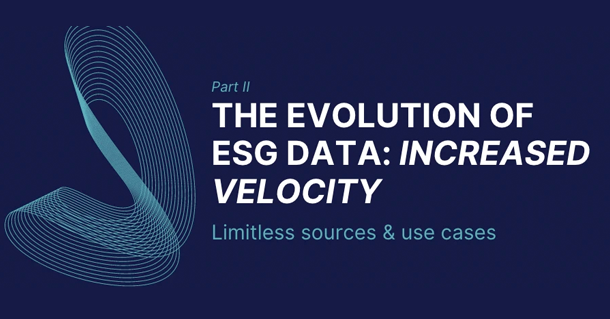
The exponential growth of ESG data, providers, and uses is limitless–learn how you can apply it to your industry and organization.
This is part II of our three-part ESG series. You can find part I here.
In part I of our ESG series, The Evolution of ESG Data: Trend to Mainstream, we covered the foundation and rise of ESG data, and what the experts had to say about its promising future.
Part I concluded with predictions of ESG’s impact in 2022, which is now halfway over. The predictions from Skadden, Arps, Slate, Meagher & Flom LLP and Affiliates were:
Spoiler alert: these predictions are shaping up to be spot on. They can be boiled down into two main categories: expansion of ESG use cases and changes in ESG standardization at all levels. These two ideas are intertwined, as changes in regulations can limit some use cases and open up access to others. Private organizations may need to alter how they use and track ESG data, while government and public organizations can maintain current regulations
When we covered the history of the rising popularity of ESG data in part I, we established that ESG first got its footing following the demand for socially responsible investing options, and as a response to an increase in manmade disasters and corporate scandals. Because of this foundation in ethics, the first huge use cases for ESG data were focused on investing. Asset managers were tasked with determining if the companies they invested in were worth it–from a humanitarian perspective, instead of a fiscal one.
This led to initial use cases for ESG data steeped in investing. Across the board, investors recognized the fiduciary duty they had to provide their clients with options for investing in companies that put their money where their mouth was when it came to promises about the environment, employee relations, and responses to ever-changing government policies.
“We focus on sustainability not because we’re environmentalists, but because we’re capitalists and fiduciaries to our clients.”
Larry Fink, Chairman & CEO, BlackRock
As data suppliers began popping up promising access to data supporting or exploiting companies and their business practices related to those environmental, social, and governance factors, it became obvious that companies who could evaluate themselves first had a competitive advantage. And so this initial use case became two-sided–investors needed to evaluate organizations' practices as well as evaluate themselves against the same standards.
Companies willing to collect, analyze and share their ESG data also gained more veracity in the eyes of the consumer. With greenwashing running rampant, companies who could prove they stood by their promises to reduce carbon emissions or increase employee diversity became more desirable for both investors and consumers alike.
This type of financially-incentivized use case is still what’s most common in ESG usage today, but likely not for long. As the amount of ESG data grows, the creative juices have started flowing and it’s being applied to new use cases outside of the investment industry. Because of the mass increase in the sheer volume of data and the limitless possibilities it holds, it’s critical for any company–public or private, financial or not–to understand how ESG data can be used to make better strategic business decisions.
The introduction of ESG data also created a gap for a new industry to fill–ESG data providers and rating services. As an external data source, ESG data can come in any format, and tends to be subjective since heaps of the data collected may not be quantitative, and even if it is, its evaluation methodology is subjective.
Financial institutions didn’t have the time or resources to dedicate to filling this gap themselves, resulting in companies delivering rating services. These companies collect and analyze the data on your behalf, and are battling to become the standard for evaluating ESG data since there currently isn’t one.
“The majority of firms (74%) are relying on external ESG rating services for the bulk of their data.”
Alveo Research, published in FinExtra
In today’s external data market, these suppliers can generally be categorized into one of three groups: market data providers, ESG providers, or specialized providers. These market providers offer access to a variety of data outside of ESG specifically. Oftentimes, these providers also offer tools, platforms, or other services that help investors evaluate the information provided. Bloomberg and MSCI are examples of market data providers.
ESG providers focus their data deliverables specifically on ESG-specific data, and a majority of the time they also offer their own analysis methodology and ratings. Each provider offers its own proprietary technique, and these are the types of organizations that are looking to influence the standardization of ESG data. Examples of ESG providers include Arabesque, Sustainanalytics, and Goby Inc.
Another niche group bloomed from ESG providers–specialized providers. These suppliers only provide data and analysis on a specific vertical of ESG data, whether it’s the carbon footprint and fossil fuel usage or diversity metrics and gender distribution. This concentration allows vendors to provide both data and analytical support for specific use cases, like identifying areas for growth in renewable energy or spotting potential risks like a labor strike.
“It’s obvious that ESG data has become more than just a 'nice to have'; it is now a major consideration for investment decisions and overall business growth.”
Omri Orgad, Regional Managing Director at Bright Data
With the help of these data providers, the external data market has become a necessity for any business who wants to meet the new demands. 76% of consumers surveyed by PwC in their 2021 Consumer Intelligence Series say “I will discontinue my relationship with companies that treat the environment, employees, or the community in which they operate poorly.” But if you’re not a financial institution or publicly traded company, where do you start with ESG data usage to satisfy consumer desire?
While the possibilities are endless for using ESG data, there are new use cases gaining traction. The wide breadth of information ESG data contains means that it can be used both holistically or piecemeal to provide more context in a variety of situations. Many industries impacted by supply chain challenges, such as food, retail, and logistics, are supplementing their internal data with third-party ESG data.
But before we dive into these use cases, let’s quickly review the why behind the what. Integrating ESG into your business is critical, regardless of your industry. According to McKinsey, ESG creates value in a variety of ways. It can:
McKinsey also states that it isn’t just financial institutions who face increased risk if they don’t incorporate ESG data into their business practices. In their “Five Ways that ESG Creates Value” report, they calculated the estimated earnings before interest, taxes, depreciation, and amortization (EBITDA) for eight industries. While banks faced a risk of 50-60% of EBITDA at stake, the automotive, aerospace & defense, and tech industries also faced the same amount of risk. The graphic below shows the risk for other industries as well.
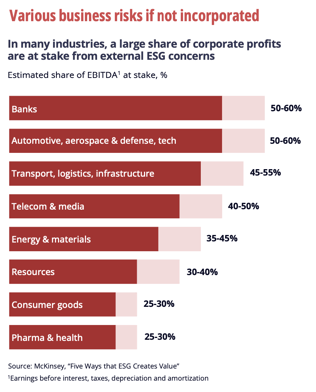
The common thread for most of these industries is supply chain. Whether it’s a horizontal or vertical supply chain, most industries have some kind of goods or supplies that are affected by changes in supply and demand, which makes supply chain management a perfect use case for ESG data.
Because supply chain touches almost every industry, we’re going to use a hypothetical example to understand how quickly supply chain can change and the amount of data available to help navigate these instant changes. Imagine a poultry farm that raises chickens and then distributes the meat to a variety of vendors for consumption.
Traditional, internal sources for this farm include data like historical revenue, forecasts, partnerships, and customer feedback. Yet by supplementing this information with third-party data at the micro and macroeconomic levels, new insights can be used to make better business decisions. This includes information on the competition, consumption trends by location, regional seasonality, the impact of weather on shipping, and more. This additional context provides a deeper understanding of your business market and is only possible with external ESG data.
At any level, that data can be classified as having a direct or indirect impact on revenue in the short and long-term of our poultry farm. Direct data may be the more obviously-related information, such as statistics on other poultry farms, USDA trends, and the Avian flu. But adding ESG data to the analysis gives even more context to the direct and indirect impacts–things like COVID-19, waste management, carbon footprint, fair labor practices, and the rise of vegetarian and vegan options–all of which can have an impact on poultry production and sales.
All of this data can be categorized as an environmental, social, or governance factor–ESG. Adding new ESG data to your analysts’ tool kit upfront ensures they can better forecast the impact these trends will have and proactively manage the risk, instead of being blindsided by breaking news.
Kohl’s, a national chain department store, is infamous for their Kohl’s cash and constant coupons that give customers the illusion that they save more than they spend. They’ve been on a mission for the past few years to improve their data tech stack, and that included moving to the cloud (the Google Cloud and BigQuery) and integrating third-party data into their customer analytics.
Third-party machine learning (ML) models and datasets are being used to help retailers predict customer behavior, and personalize products and messages for customers. By combining customer information with third-party ESG data Kohl’s built a model that was able to identify the type of work a customer performed, which in turn provided insight into the type of shoes they preferred for work. As a result, Kohl’s launched a highly personalized shoe advertising campaign to drive more shoe sales.
The potential for leveraging ESG data in retail is endless. Kohl’s CTO Paul Gaffney says that “hyper-locationalization is among the most “exciting” applications of third-party data.” He continues by saying that Kohl’s is also looking “to apply machine learning to a mix of first- and third-party data to make highly targeted merchandising decisions and to determine where to open stores based on a matrix of thousands of data points.”
Everywhere you turn these days, there’s a new use for blockchain, cryptocurrency, and AI. These technologies demand massive amounts of computing power, and that isn’t environmentally friendly. To keep advancing technology but match customer expectations for environmentally-oriented companies, businesses are turning to ESG data to redeem their consumption levels.
As these tech companies make promises to reduce their carbon footprint, recycle production materials, and use energy-efficient offices, they’re facing the same issue financial institutions faced with greenwashing years ago–they have to prove they’re following through on their promises through an unbiased means. ESG data can be purchased to track an organization’s progress and shortcomings, which can attract investors and consumers alike if it’s done right.
These are just a few of the possibilities for ESG data usage. There’s room for other industries to begin exploring and experimenting with ESG data in their current analytical practices to give themselves a competitive advantage. This pattern of expanding data sources will lead industries like transportation, energy, and healthcare to adopt ESG data. This will also lead to changes in the most popular ESG data sources, as providers work to win the business of these newer industries.
"For companies in the transportation industry that could mean determining the future costs and savings of having an electric fleet as opposed to gas-fueled vehicles or it could mean calculating the value of the business opportunity. There’s value in setting up a more sustainably-fueled fleet of delivery vehicles that can serve cities that will require more environmentally friendly vehicles in the future, she said."
Kristin Moyer, Distinguished VP & Analyst at Gartner
“The least common source of data are the corporates themselves.”
Alveo Research, published in FinExtra
In today’s market, there are multitudes of ESG data providers–some specialize, and some are generalists. But even though the competition is aplenty, it’s beneficial to consumers. According to EY, most finance services firms use 2-5 different third-party ESG data providers.
“Our analysis of more than 60 of the largest financial services firms across Europe and the US shows that most companies use between 2 and 5 different providers, while some even use up to 10 different third-party vendors to cover their ESG data needs. Clearly, there’s no single all-singing, all-dancing ESG data solution that fits all needs.”
Mike Zehetmayer & Natalie Brandau, EY
EY also provides a framework organizations can use to navigate the plethora of resources, starting with focusing on what it is precisely that your business needs. From there, your needs can be used to develop an evaluation framework that’s specific to your company. They also state that it’s critical to create a corresponding ESG integration strategy and roadmap, and we agree. For more information on developing an ESG data pipeline, check out this blog.
Here’s a snapshot of some of the leading data sources in today’s market, which includes top organizations such as Accern, BoardEx, Bloomberg, CSR Hub, Eurostat, FTSE Russell, G&S Quotient, ISS ESG, Moody’s Analytics, MSCI, MT Newswires, RepRisk, RS Metrics, SIX, Sustainalytics, STOXX, and more.
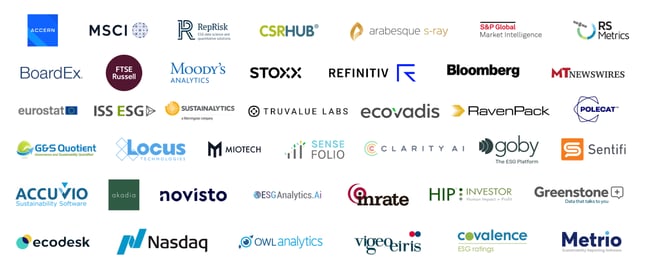
Instead of regurgitating sentiments around the current state of ESG regulations, we’re going to share direct quotes from ESG data consumers who are intimately familiar with the current landscape of ESG regulations–or rather, the lack thereof.
“There are just simply too many acronyms out there — there’s too many frameworks,” according to Trevor David, client relations director at Sustainalytics.”
“It’s really hard to keep track,” David said on April 26 during a webinar sponsored by Crux Informatics, adding that the number of ESG regulations and standards worldwide has nearly doubled during the past five years.”
Trevor David, Client Relations Director at Sustainalytics
“We really need to the greatest degree possible for ESG data to be following the same evolution that financial accounting standards have followed and apply some of those principles to ESG data to the extent possible, recognizing it is different data, there are different challenges,” according to Jennifer Grzech, responsible investing director at Nuveen.
Jennifer Grzech, Responsible Investing Director at Nuveen
“When it comes to data, the concept of “garbage in, garbage out” applies to green investing as much as other investment strategies. While investors need a baseline level of standardized data to support relevance, objectivity and comparability, they face fragmented data from multiple sources, including company reports, news articles, data vendors and rating agencies.”
Mike Zehetmayer & Natalie Brandau, EY
“Given the diverse nature of the potential data points, ESG data varies in type and size, which makes it complex and daunting to collect and understand.”
Omri Orgad, Regional Managing Director at Bright Data
"Multiple data providers - each operating with its own data sources, frameworks and scoring methodologies - underpin investment decision-making. Without a set of global industry standards to facilitate company performance benchmarking, there is lack of consistency, timeliness, and transparency across the ESG data landscape."
Harish Arora, Managing Director, Financial Services Technology Consulting Practice, EY
In summary, substantial regulations of ESG data and its evaluation methodology has moved from a want to a need for data consumers. The way forward with ESG remaining a critical third-party data source is by leveling the playing field so that each source speaks the same language. However, the reach of those standards is up for debate and may vary by company size, industry, and tax status.
Just as there’s no lack of opinions on the current state of ESG regulations, there’s also a vast array of opinions on the best way to combat this gap. Leadership from government agencies, big data entities, and data consumers alike all have thoughts on the best way to regulate ESG data moving forward. But the standardization looming on the horizon isn’t the only piece at play in what’s to come. Changes in legislation can also impact what regulation looks like–from supreme court to decisions to specific political parties holding power, these suggestions can change in one news cycle.
Here are a few snippets of what these leaders are pushing for and thinking:
“The idea behind the SFDR is to mitigate the effect of so-called 'greenwashing' and to protect the credibility of the growing but still nascent sustainable investment market.”
Alveo Research, published in FinExtra
“It’s not like any transformation any of us have ever seen,” Moyer said during a talk at the Gartner CFO and Finance Executive Conference Monday. “Digital business is probably a 10-to-20-year transformation. ESG is a 30-to-40-year transformation.”
Kristin Moyer, Distinguished VP & Analyst at Gartner
"In its recent decision on West Virginia v. Environmental Protection Agency (EPA), the U.S. Supreme Court ruled that the EPA did not have the power to regulate emissions from existing power plants via generation shifting requirements. This raised questions on the EPA’s ability to regulate emissions in the future, as well as the power of federal agencies to regulate such things as tech regulations on data privacy and net neutrality."
Joao-Pierre S. Ruth, Senior Writer, Information Week
“Companies are being asked by investors to produce more and more information on ESG, as this becomes more mainstream, but there is no standardisation of this information,” said Bollon, whose board advises the European Commission on employers’ issues. “Data providers are now a key part of the financial chain and I do not see why this key part — ratings are important — isn’t under scrutiny somewhere,” he added, pointing out that, in contrast, asset managers, brokers and stock exchanges were all regulated.”
We’ve covered the origins of ESG, how it’s used, and where you can find it. We’ve even touched on the bigger picture surrounding ESG, and what its future may look like from a regulatory perspective. So now what?
In our third and final piece of this ESG series, we’ll explore tools and products available in the ESG marketplace, ranging from rating methodologies to cloud providers. In the meantime, check out some of our other ESG resources or visit our page on ESG Data Integration to learn more.
Additional Resources:

Scout has worked in tech startups almost exclusively and writes everything from social media to full reports. She's an Ohio native who loves to binge the latest series or read thriller novels in her free time.

Not long ago, we observed here in our blog that the critical insights that drive business value come from data that is both (1) fast and (2) reliable.
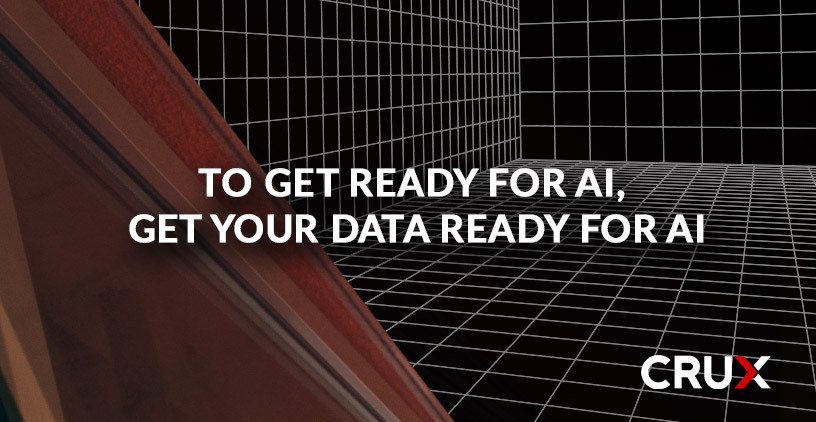
This past year has been exciting, representing the dawning of a new age for artificial intelligence (AI) and machine learning (ML)—with large...
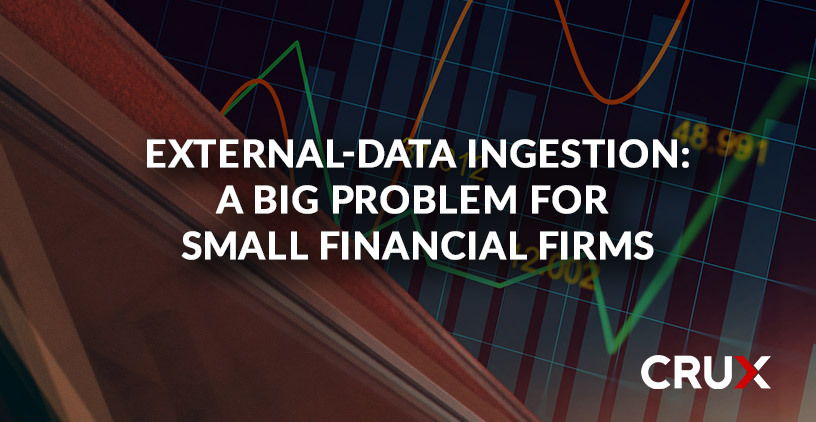
How do you get white-glove customer service from a major data supplier?